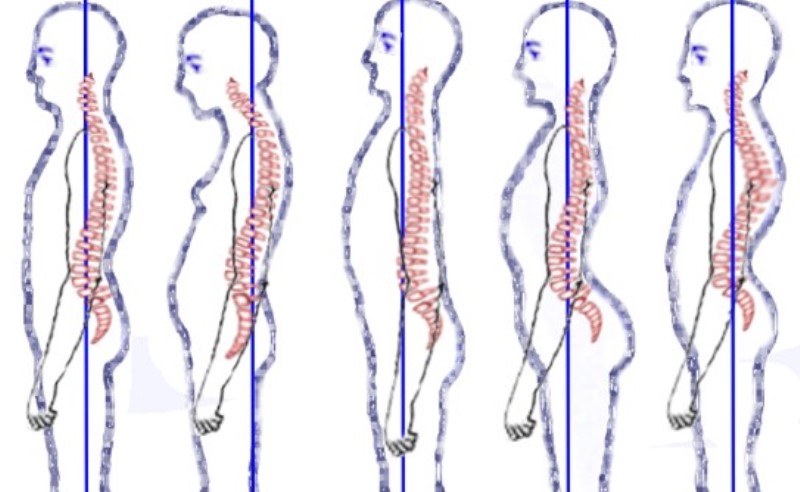Our posture not only talks about whether or not our joints and muscles are working to their best efficiencies, but also says a whole heap about our personality. As such, we thought a guide on how to improve your posture was essential, and set about writing one! Here is every single detail you MUST know about possible postural deviations, and how you can fix them.
Suggested read: Get that coveted toned look, with yoga exercises
We live our lives with hunched spines and out-of-shape hips, enduring the pain, as if it is normal because everyone is going through the same thing. Little do we think that living with a bad posture might be a very dangerous thing. Various problems can arise from a bad posture, like, headaches, stiffness, chronic shoulder and back pain, hip injuries, lethargy, difficulty in breathing, nerve compression, improper digestion, muscle weakness, to name a few.
The culprits of bad posture
1. Texting

Image source: Google, copyright-free image, under Creative Commons License
According to a latest study, one an average people today spend around 37 hours of a month using various phone apps. The time spent staring at the phone indicates the number of hours we sit hanging our head downwards in a 60-degree angle.
Dr Dennis Enix, Associate Professor at Logan University in Saint Louis points out,
“A study in the journal Surgical Technology International says the average adult head weighs between 10 to 20 pounds. However, the force of the headed titled down at a 60-degree angle puts 60 pounds of weight on the neck and shoulders.”
Oh my God! Never thought of that, did we?! Well, your texting habit is not only a pain in the neck, like literally, but because of it, you also run the risk of cervical tension headaches, strains in the neck, and herniated spine disks.
Dr. Enix goes on to suggest a remedy. He says,
“While texting, try to sit or stand upright with your shoulders square and the screen somewhat elevated so you are not looking down as much. Being aware of your back, shoulders and neck will help remind you to avoid a hunched position while you are texting and avoid bad posture problems.”
2. Sitting is the new smoking

Image source: Google, copyright-free image, under Creative Commons License
A new poll has revealed that the average number of work hours is now 47 hours a week! Sitting at your desk for such a prolonged period of time, is dangerous because of the posture: Back hunched over, pelvis tilted, and head dropped forward. But you got to work, right? So how do you solve the problem?
According to Katy Bowman, Biomechanist and Founder of the Restorative Exercise Institute,
“There is not a single ‘best’ posture to be still in the bulk of the day — the problem is the all-day stillness. Strive to mix it up throughout the day by changing your work position.”
You can improve the desk posture by sitting cross-legged at times, or using a standing desk, at another instance. Also, you MUST take walking breaks after every two hours.
3. Sleeping wrong

Image source: Google, copyright-free image, under Creative Commons License
We may not be getting the much-needed 8 hours sleep, but we do spend a quarter of our lives catching those 40 winks! According to Dr. Todd Sinett, a NYC-based chiropractor,
“We spend so much of our day curled forward and hunched over our computers and smartphones that our spines are bent forward in a curved C-like pattern. When we get into bed, we want to avoid continuing that C-like pattern.”
Here’s what Todd suggests as a remedy:
“My overall sentiment is that people should sleep however they are comfortable to ensure their body gets the most rest. But make sure you aren’t sleeping with more than one pillow (under their head).”
You should also try supporting your hips by using a pillow between your legs. Furthermore, watching TV or reading in bed is a no-no, not only since it strains the neck, but also because it worsens your sleep. Use your bed only for sleep, and sex, of course!
How to improve your posture
To improve your posture, you first need to be aware of the most common deviations. Below, we look at these abnormalities caused by overactive and underactive muscles. We will identify the muscles, and then, talk about the exercises that can help restore the balance.
Assess your posture
If you think your body does not look straight while standing, you might be having one or more of these postural deviations:
1. Sway back: Your hips press forward, and are placed in front of the ribs
If you have this postural deviation, your overactive muscles are your hamstrings, gluteus maximus and medius, eretor spinae, your glutes and low back.
The stretches that are best to relax your overactive muscles are the runner’s stretch, seated glute stretch, a lying crossover, a hamstring stretch and foam rolling.
Your underactive muscles are Iliopsoas, external oblique, hip flexors and lower abs.
To strengthen these muscles, you need to perform the cocoon, ball pull-in, hanging leg raise and scissor kick.
Suggested read: The complete guide to Callanetics exercises and why you should try it
2. Lower-cross syndrome: Your low back is an excessive curve and your pelvis is tilted forward
If you have this postural deviation, your overactive muscles are your Iliopsoas, hip flexors and lower back.
The stretches that are best to relax your overactive muscles are pyramid stretch over ball, kneeling hip flexor, quadriceps stretch, quadriceps self-myofascial release, and hug knees to chest.
Your underactive muscles are your abs and glutes.
To strengthen these muscles, you need to perform the pelvic tilt to bridge, single-leg glute bridge, exercise-ball hip bridge, leg-elevated crunch and frog sit-up.
3. Curved shoulders: Your shoulders are tilted forward and placed in front of your ears
If you have this postural deviation, your overactive muscles are your chest muscles.
The stretches that are best to relax your overactive muscles are front deltoid stretch, elbows-back stretch, chest stretch on stability ball, dynamic chest stretch, and chair upper-body stretch.
Your underactive muscles are your muscles in the back (around the shoulder blades) and rear delts.
To strengthen these muscles, you need to perform the seated cable row, back fly with band, shoulder external rotation, and rear delt row.
4. Headfirst, like literally: Your ears are way ahead of your shoulders
If you have this postural deviation, your overactive muscles are muscles behind the neck and those which help tilt the head back.
The stretches that are best to relax your overactive muscles are the neck self-myofascial release, chin to chest, and the sternocleidomastoid stretch.
Your underactive muscles are your muscles which are in front of the neck, which help the head tilt forward.
To strengthen these muscles, you need to perform the Isometric front-neck exercise.
5. Upper-cross syndrome: Your shoulders are rounded forming an excessive curve
If you have this postural deviation, your overactive muscles are muscles at the back of your neck, your traps, the upper back, and your chest.
The stretches that are best to relax your overactive muscles are the neck self-myofascial release, elbows-back stretch, chin to chest, chest stretch on a ball, dynamic chest stretch, and chair upper-body stretch.
Your underactive muscles are your muscles in the back around the shoulder blades, and in front of your neck.
To strengthen these muscles, you need to perform the Isometric front-neck exercise, seated cable row, back fly with band, and shoulder external rotation.
Years of stooping and being inactive have caused some of our muscles to get overactive while rendering others underactive. These opposing muscles are always in a state of tug of war, and when there is an imbalance between the two, the one that pulls harder, is what our posture shifts in the direction of!
When thinking of how to improve your posture the aforementioned exercises become vital. But in case you don’t have time and all that you can incorporate into your tight schedule is a fifteen-minute walk, then let us help you get the maximum out of those fifteen minutes!

Image source: Pixabay, under Creative Commons License
First, stand tall. Imagine you won an Olympic medal. Pretend to be superman or batman, whatever works! Try and stretch yourself as tall as possible. However, keep your heels as firmly placed on the ground as possible.
Next, play a game, called, Getting Your Shoulders As Far As Possible From Your Ears. Yea, I made the name up, but what is in a name, eh?! Now bring your shoulders down by shrugging your shoulders all the way up and then pulling them all the way down, as down as possible. Now, take your shoulders back. Imagine someone stabbing a pin in your back. Crush the pin with your shoulder blades. This should be done while keeping the shoulders in a down position.
Third, Imitate Captain America! Do a chest up position!
Take long strides. Walking with short strides will not help improve the posture. When you focus on long strides, you will open up the hips and it will get you stretched out for the day!
Suggested read: For real weight loss, take a walk
Was this helpful? Let us know in the comment section below.
For more on health and fitness, sign up for our daily newsletter today. Remember, you are just a click away from the body and lifestyle you have always wanted for yourself! Ciao!
Feature image source: Google, copyright-free image, under Creative Commons License













